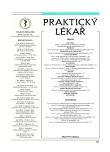Rickettsia conori – infection imported from the South African Republic
Rickettsia conori – pôvodca infekcie importovanej z Juhoafrickej republiky
Autorka v práci prezentuje kazuistiku pacientky s importovanou rickettsiózou (Rickettsia conori) z Juhoafrickej republiky. Napriek netypickému priebehu sa po vylúčení diagnózy malárie myslelo na možnú rickettsiovú infekciu, ktorá sa potvrdila serologickým vyšetrením a primerane liečila.
Kľúčové slová:
rickettsióza – importovaná nákaza – diagnostika – liečba.
Authors:
K. Šimeková
Authors‘ workplace:
III. klinika infekčních a tropických nemocí 1. LF UK, Praha
přednosta doc. MUDr. M. Holub, PhD.
Published in:
Prakt. Lék. 2005; 85(10): 573-574
Category:
Case Report
Overview
The author in her study presents a case of the female patient with risckettsiosis (Rickettsia conori) imported from the South African Republic. In spite of atypical course of the disease, after elimination of malary diagnosis, rickettsiosis infection was supposed to be possible and it was confirmed serological examination and was treated adequately.
Key words:
rickettsios – imported disease – diagnostics – treatment.
Labels
General practitioner for children and adolescents General practitioner for adultsArticle was published in
General Practitioner

2005 Issue 10
- Metamizole at a Glance and in Practice – Effective Non-Opioid Analgesic for All Ages
- Memantine in Dementia Therapy – Current Findings and Possible Future Applications
- What Effect Can Be Expected from Limosilactobacillus reuteri in Mucositis and Peri-Implantitis?
- Metamizole in perioperative treatment in children under 14 years – results of a questionnaire survey from practice
- Memantine Eases Daily Life for Patients and Caregivers
Most read in this issue
- Infantile autism from the point of view of developmental psychopathology. Theory of the psychological basis of autism
- Recent view on the pathophysiology and pharmacotherapy of the depressive disorder
- Rickettsia conori – infection imported from the South African Republic
- Surgical treatment of laryngeal carcinoma
